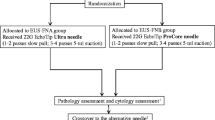Abstract
Background
The differentiation between benign and malignant abdominal lymph nodes is difficult, especially if no primary site is evident or if cancer resection was remote in time. The aim of this study was to evaluate the yield of endoscopic ultrasound-guided fine-needle aspiration (EUS-FNA) in patients with undiagnosed intra-abdominal lymphadenopathy.
Methods
Fifty-seven consecutive patients with undiagnosed abdominal lymphadenopathy who were registered in our EUS-FNA database from January 1997 to December 2007 were reviewed. EUS-FNA was carried out using a 22-G needle. The final pathological diagnosis was based on the cytopathological, histological, and immunohistochemical (IHC) findings.
Results
Adequate specimens were obtained in 93% cases. The final diagnoses included local recurrence of malignancy after resection (n = 16), lymphoma (n = 12), and benign/reactive changes (n = 17). The sensitivity, specificity, positive predictive value, negative predictive value and overall accuracy of EUS-FNA were 94, 100, 100, 90 and 96%, respectively. In addition, it was also possible to classify lymphoma subtypes in 83% of cases. No complications occurred during the procedures.
Conclusions
EUS-FNA is clinically very useful for establishing the diagnosis of abdominal lymphadenopathy of unknown cause and can provide sufficient tissue for IHC and subtyping of lymphomas.
Similar content being viewed by others
References
Tio TL, Sie LH, Tytgat GN. Endosonography and cytology in diagnosing and staging pancreatic body and tail carcinoma. Preliminary results of endosonographic guided puncture. Dig Dis Sci. 1993;38:59–64.
Caletti G, Odegaard S, Rösch T, Sivak MV, Tio TL, Yasuda K. Endoscopic ultrasonography (EUS): a summary of the conclusions of the working party for the tenth world congress of gastroenterology Los Angeles, California October, 1994. The working group on endoscopic ultrasonography. Am J Gastroenterol. 1994;89(8 Suppl):S138–43.
Harewood GC, Wiersema MJ. Endosonography-guided fine needle aspiration biopsy in the evaluation of pancreatic mass. Am J Gastroenterol. 2002;97:1386–91.
Tada M, Komatsu Y, Kawabe T, Sasahira N, Isayama H, Toda N. Quantitative analysis of K-ras gene mutation in pancreatic tissue obtained by endoscopic ultrasonography-guided fine needle aspiration: clinical utility diagnosis of pancreatic tumor. Am J Gastroenterol. 2002;97:1386–90.
Chang KJ, Nguyen P, Erickson RA, Durbin TE, Katz KD. The clinical utility of endoscopic ultrasound-guided fine-needle aspiration in the diagnosis and staging of pancreatic carcinoma. Gastrointest Endosc. 1997;45:387–93.
Catalano MF, Sivak MV Jr, Rice T, Gragg LA, Van Dam J. Endosonographic features predictive of lymph node metastasis. Gastrointest Endosc. 1994;40:442–6.
Vilmann P, Hancke S, Henriksen FW, Jacobsen GK. Endoscopic ultrasonography-guided fine-needle aspiration biopsy of lesions in the upper gastrointestinal tract. Gastrointest Endosc. 1995;41:230–5.
Bluemke DA, Abrams RA, Yeo CJ, Cameron JL, Fishman EK. Recurrent pancreatic adenocarcinoma: spiral CT evaluation following the Whipple procedure. Radiographics. 1997;17:303–13.
Belli P, Costantini M, Romani M, Marano P, Pastore G. Magnetic resonance imaging in breast cancer recurrence. Breast Cancer Res Treat. 2002;73:223–35.
De Potter T, Flamen P, Van Cutsem E, Penninckx F, Filez L, Bormans G, et al. Whole-body PET with FDG for the diagnosis of recurrent gastric cancer. Eur J Nucl Med Mol Imaging. 2002;29:525–9.
Dewitt J, Ghorai S, Kahi C, Leblanc J, McHenry L, Chappo J, et al. EUS-FNA of recurrent postoperative extraluminal and metastatic malignancy. Gastrointest Endosc. 2003;58:542–8.
Kwong YL. Predicting the outcome in non-Hodgkin lymphoma with molecular markers. Br J Haematol. 2007;137:273–87.
Ribeiro A, Vazquez-Sequeiros E, Wiersema LM, Wang KK, Clain JE, Wiersema MJ. EUS-guided fine-needle aspiration combined with flow cytometry and immunocytochemistry in the diagnosis of lymphoma. Gastrointest Endosc. 2001;53:485–91.
Richard DM. The art and science of cytopathology. Aspiration cytology. Chicago: ASCP; 1996.
Yasuda I, Tsurumi H, Omar S, Iwashita T, Kojima Y, Yamada T, et al. Endoscopic ultrasound-guided fine-needle aspiration biopsy for lymphadenopathy of unknown origin. Endoscopy. 2006;38:919–24.
Author information
Authors and Affiliations
Corresponding author
Rights and permissions
About this article
Cite this article
Nakahara, O., Yamao, K., Bhatia, V. et al. Usefulness of endoscopic ultrasound-guided fine needle aspiration (EUS-FNA) for undiagnosed intra-abdominal lymphadenopathy. J Gastroenterol 44, 562–567 (2009). https://doi.org/10.1007/s00535-009-0048-4
Received:
Accepted:
Published:
Issue Date:
DOI: https://doi.org/10.1007/s00535-009-0048-4




